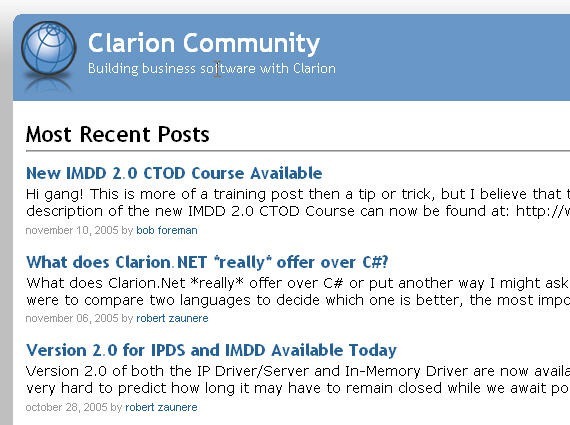Capesoft are a company that creates 3rd Party tools for Clarion. As I’ve posted before, if you don’t know about Clarion, then take a gander. It’s an awesome development tool, taking away a lot of the pain of C++ and other languages like it by allowing you to bypass creation of stock tools, and get into the meat of designing software.
Part of the frustration with shipping software is the updating of any changes within the database. How do you do it? What convoluted mess of code do you have to copy, swap, call upgrade, hope noone is using, check for exclusive access … I’m not even sure how people writing in other languages cope. I guess you write you own upgrade tool.
Well, that’s what the guys at Capesoft have done. File Manager 3 (FM3) is a template that helps push Clarion from a "cool nifty enthusiast language" to "let’s change the world and create cold fusion while we’re at it" development tool.
Basically, it’s like this. In Clarion you have a dictionary, which contains the file structures, and you have an app, which contains the windows, the code, the look. When you change a field within a table, the physical file is required to undergo an upgrade. The process to upgrade your user’s files was complicated (as opposed to getting them to send you the file, upgrading yourself through the dictionary interface, and then sending it back), and created a lot of hassle.
FM3 takes all this hassle, crumples it up, throws it into the ditch, because the bin is too good for it, fills the ditch with gasoline, lights the ditch, then laughs at the stupidity of it all.
You plug FM3 into your application, setup whatever parts you need, and then bam … the files upgrade when your exe is run. There are some addendums to this, but at it’s heart, this is what FM3 does. Takes away any of the pain associated with changing File Structures and let’s you get on with the real job … coding up a storm.
So go take a look at Capesoft. Anyone who uses Clarion will most like already know about them, they’re that popular.
—
More Clarion 3rd Party Dev Shouts to come … and probably looks at other tools too. It’s all good.

